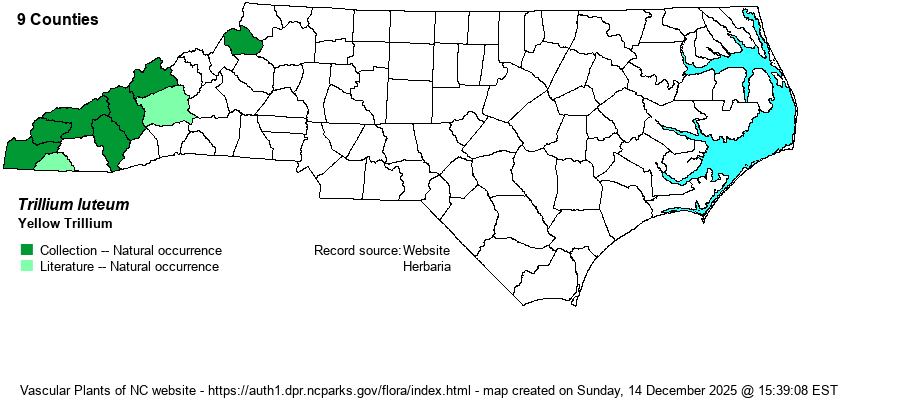| Author | (Muhlenberg) Harbison | |
| Distribution | Occurs in the southwestern quarter of the Mountains, primarily close to the TN line from Madison County southwestward. The specimen from Watauga County is correctly identified, but it perhaps is not native that far north. The iNaturalist website has a number of yellow-flowered photos from additional counties in the Mountains -- submitted and often accepted as this species -- that may be correct, but has the yellow form of T. cuneatum been eliminated from consideration? And, are they native in some of these counties well east or southeast of the TN state line? As a result, the website editors are wary of adding iNaturalist records at the present time, although several were added. It does not occur on Atlantic drainage slopes.
This is a species whose range is centered around eastern TN. It ranges north to southern KY, east to extreme western NC, and south only to northern GA and central AL. Records from SC on the BONAP map are not of native populations, as this species is clearly one of Tennessee/Gulf drainages and not of Atlantic drainages. Records for the northern half of AL are also of uncertain provenance. It might just be native in four states -- KY, TN, NC, and GA. | |
| Abundance | Though the NC NHP gives the species a State Rank of S2S3, it is actually quite common (to locally abundant) in the Great Smoky Mountains, being easily found in the national park and in nearby counties. It is less common in the extreme southwestern counties, but best called infrequent there. A rank of S3 is perhaps more appropriate. | |
| Habitat | This species favors rich, circumneutral soils of moist forests, being a common component of Rich Cove Forests in counties bordering TN from Madison County southward. It prefers lower elevations in the mountains, not typically seen in Northern Hardwood Forests. |
| Phenology | Blooms from mid-March to late April; fruits from late May into June. | |
| Identification | This species is basically a yellow counterpart of T.cuneatum, though that species does have forms with yellow or greenish-yellow flowers. T. luteum is a fairly low species, growing to about 9 inches tall, with three mottled leaves, generally with patches of light green mixed with medium green. The three leaves are ovate and about 4-5 inches long; they tend to be angled downward as in T. cuneatum. Like that species, the flowers are sessile and have generally erect to slightly spreading petals; these three petals average 2 inches long are are usually bright yellow to slightly greenish-yellow. It is separated from the yellow-flowered form of T. cuneatum by the ovary and stamens all being yellow, to match the flower color; T. cuneatum has some maroon/purple on the reproductive parts at the base of the flower, and thus contrasting with the yellow petals. The yellow-flowered T. discolor has a range to the east of T. luteum, it has pale yellow flowers, and the petals are shorter and with rounded tips. This is one of the most common and showiest of the spring-flowering wildflowers in lower elevations of Great Smoky Mountains National Park, giving the herb layer a band of bright yellow where it is abundant. | |
| Taxonomic Comments | For much of the last century it was lumped in with T. cuneatum as a variety -- T. cuneatum var. luteum (as in RAB 1968). In recent years there has been much better understanding of the taxonomy of the genus, and most recent references agree that nearly all former varieties are good full species now.
| |
| Other Common Name(s) | Yellow Wake-robin | |
| State Rank | S2S3 [S3] | |
| Global Rank | G4 | |
| State Status | | |
| US Status | | |
| USACE-agcp | | |
| USACE-emp | | |

